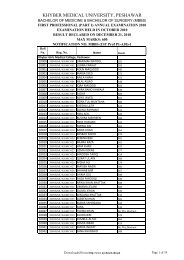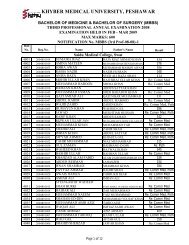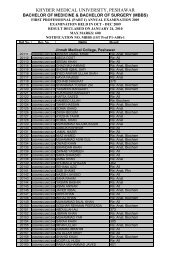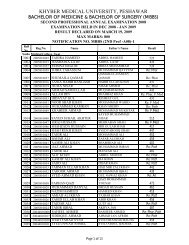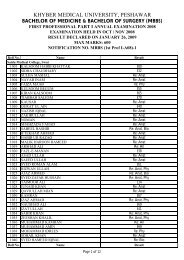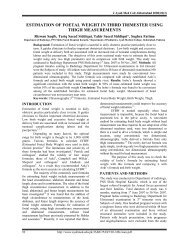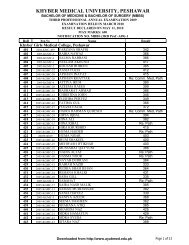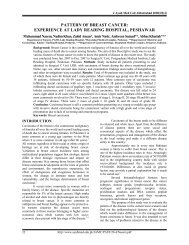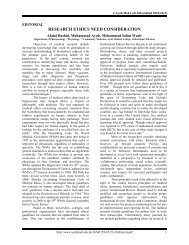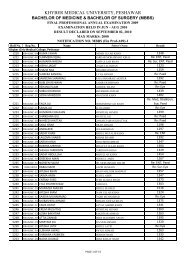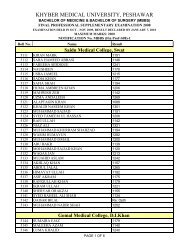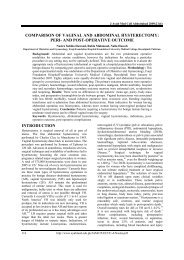coeliac disease in children presenting with failure to thrive
coeliac disease in children presenting with failure to thrive
coeliac disease in children presenting with failure to thrive
You also want an ePaper? Increase the reach of your titles
YUMPU automatically turns print PDFs into web optimized ePapers that Google loves.
J Ayub Med Coll Abbottabad 2011;23(4)<br />
ORIGINAL ARTICLE<br />
COELIAC DISEASE IN CHILDREN<br />
PRESENTING WITH FAILURE TO THRIVE<br />
Muhammad Asim Ikram, Aisha Sajid, Sadia Hameed, Kashan Arshad, Irshad-ul-Haq<br />
Department of Paediatrics, Mad<strong>in</strong>a Teach<strong>in</strong>g Hospital, University Medical and Dental College, Faisalabad, Pakistan<br />
Background: Coeliac <strong>disease</strong> used <strong>to</strong> be considered as a <strong>disease</strong> of European and Western population<br />
but now it has emerged as a global problem. Objective of this study was <strong>to</strong> evaluate the frequency and<br />
mode of presentation of <strong>coeliac</strong> <strong>disease</strong> <strong>in</strong> <strong>children</strong> present<strong>in</strong>g <strong>with</strong> <strong>failure</strong> <strong>to</strong> <strong>thrive</strong>. Methods: This<br />
cross-sectional descriptive study was conducted at Paediatrics Department of Mad<strong>in</strong>a Teach<strong>in</strong>g<br />
Hospital <strong>in</strong> collaboration <strong>with</strong> His<strong>to</strong>pathology Department of University Medical and Dental College,<br />
Faisalabad over a period from April 2010 <strong>to</strong> March 2011. A <strong>to</strong>tal of 60 <strong>children</strong>, aged 4–6 years<br />
present<strong>in</strong>g as <strong>failure</strong> <strong>to</strong> <strong>thrive</strong> accord<strong>in</strong>g <strong>to</strong> their height and weight, were <strong>in</strong>cluded. Relevant<br />
<strong>in</strong>vestigations were done along <strong>with</strong> radiological assessment of bone age. The jejunal biopsy was taken<br />
<strong>in</strong> all the patients. Children who were suffer<strong>in</strong>g from primary or secondary malnutrition due <strong>to</strong> other<br />
chronic illnesses and malabsorptive syndromes were excluded from the study. The data was analysed<br />
us<strong>in</strong>g SPSS-17. Chi-square test was used and p
J Ayub Med Coll Abbottabad 2011;23(4)<br />
targeted screen<strong>in</strong>g, and 16% presented <strong>with</strong> non-specific<br />
recurrent abdom<strong>in</strong>al pa<strong>in</strong>. 19,20 Another trend <strong>in</strong> <strong>coeliac</strong><br />
<strong>disease</strong> is the presentation later <strong>in</strong> life <strong>with</strong> atypical<br />
symp<strong>to</strong>ms such as anaemia, bone disorders or<br />
au<strong>to</strong>immune <strong>disease</strong>s. 18 Untreated <strong>coeliac</strong> <strong>disease</strong> will<br />
lead <strong>to</strong> short stature, delayed puberty, anaemia, rickets,<br />
<strong>in</strong>test<strong>in</strong>al lymphoma, psychiatric problems and even<br />
miscarriages.<br />
Keep<strong>in</strong>g <strong>in</strong> m<strong>in</strong>d these chang<strong>in</strong>g trends <strong>in</strong> the<br />
cl<strong>in</strong>ical presentation, <strong>coeliac</strong> <strong>disease</strong> can be recognised<br />
earlier if we consider perform<strong>in</strong>g the screen<strong>in</strong>g and<br />
diagnostic tests <strong>in</strong> patients present<strong>in</strong>g <strong>with</strong> <strong>failure</strong> <strong>to</strong><br />
<strong>thrive</strong>, short stature and pallor. After identify<strong>in</strong>g these<br />
patients, and by start<strong>in</strong>g gluten-free diet, many serious<br />
complications of the <strong>disease</strong> can be avoided. Objective<br />
of this study was <strong>to</strong> evaluate the frequency and mode of<br />
presentation of <strong>coeliac</strong> <strong>disease</strong> <strong>in</strong> <strong>children</strong> present<strong>in</strong>g<br />
<strong>with</strong> <strong>failure</strong> <strong>to</strong> <strong>thrive</strong>.<br />
MATERIAL AND METHODS<br />
This was an OPD based cross-sectional study conducted<br />
at paediatrics department, Mad<strong>in</strong>a Teach<strong>in</strong>g Hospital <strong>in</strong><br />
collaboration <strong>with</strong> His<strong>to</strong>pathology Department,<br />
University Medical and Dental College, Faisalabad,<br />
from April 2010 <strong>to</strong> March 2011. Dur<strong>in</strong>g this time, 60<br />
<strong>children</strong>, age 4–16 years, who presented <strong>with</strong> <strong>failure</strong> <strong>to</strong><br />
<strong>thrive</strong> as assessed by their height, weight and percentile<br />
charts were enrolled. After tak<strong>in</strong>g <strong>in</strong>formed written<br />
consent from the parents, they were asked about the<br />
associated compla<strong>in</strong>ts like chronic diarrhoea (loose<br />
motions >14 days), abdom<strong>in</strong>al pa<strong>in</strong>, anorexia,<br />
polyphagea, constipation, pallor, and vomit<strong>in</strong>g. Their<br />
height and weight were taken and plotted on percentile<br />
charts. Patients were evaluated for signs of anaemia,<br />
rickets, malnutrition, clubb<strong>in</strong>g and abdom<strong>in</strong>al distension.<br />
Investigations like haemoglob<strong>in</strong>, peripheral blood<br />
picture, serum album<strong>in</strong>, Calcium, Phosphate, alkal<strong>in</strong>e<br />
phosphate and X-rays wrist were performed. Bone age<br />
of the patients was assessed radiologically and the<br />
jejunal biopsy was done <strong>in</strong> all patients that was<br />
considered as the diagnostic <strong>to</strong>ol. We were able <strong>to</strong><br />
perform Tissue Transglutam<strong>in</strong>ases <strong>in</strong> few patients<br />
because of f<strong>in</strong>ancial constra<strong>in</strong>s.<br />
Children who were suffer<strong>in</strong>g from primary or<br />
secondary malnutrition due <strong>to</strong> other chronic illnesses<br />
were excluded from the study. The data were tabulated<br />
and analysed us<strong>in</strong>g SPSS-17. Percentages of different<br />
variables were calculated. Chi-square test was used and<br />
p
J Ayub Med Coll Abbottabad 2011;23(4)<br />
and radiological determ<strong>in</strong>ation of bone age. The jejunal<br />
biopsy was performed <strong>in</strong> all 60 patients and 40% of<br />
cases turned out <strong>to</strong> be <strong>coeliac</strong> <strong>disease</strong>. Accord<strong>in</strong>g <strong>to</strong><br />
Marsh criteria, all 24 patients were classified as hav<strong>in</strong>g<br />
stage 3, similar jejunal biopsy result were found <strong>in</strong> a<br />
study done by Aziz S et al. 21 Rema<strong>in</strong><strong>in</strong>g 60% cases<br />
turned out <strong>to</strong> be non specific enteritis that is another area<br />
of further research. Gluten-sensitive enteropathy could<br />
affect the entire small bowel, but has its ma<strong>in</strong><br />
manifestation <strong>in</strong> the duodenum. 22–24 Although the<br />
presence of antibodies and human leukocyte antigen<br />
(HLA)-DQ typ<strong>in</strong>g can support the diagnosis but small<br />
bowel biopsy still rema<strong>in</strong>s an essential component of<br />
screen<strong>in</strong>g and diagnosis of <strong>coeliac</strong> <strong>disease</strong>. The<br />
prevalence of gluten sensitivity <strong>in</strong> architecturally normal<br />
small bowel is <strong>in</strong>creas<strong>in</strong>g. 25,26 So these patients need<br />
further evaluation by serological markers like Tissue<br />
Transglutam<strong>in</strong>ases and anti-endomysial antibody. In our<br />
study Tissue Transglutam<strong>in</strong>ases antibodies were<br />
performed <strong>in</strong> only 7 patients because of f<strong>in</strong>ancial<br />
constra<strong>in</strong>s.<br />
Abdom<strong>in</strong>al distension was the most common<br />
sign <strong>in</strong> our study. Chronic diarrhoea, that was<br />
considered the typical present<strong>in</strong>g feature of <strong>coeliac</strong><br />
<strong>disease</strong>, was not the major compla<strong>in</strong>t <strong>in</strong> our patients. In<br />
a study done by Aziz S et al 21 at Karachi, 69% <strong>children</strong><br />
presented <strong>with</strong> prolonged diarrhoea and 53% had<br />
abdom<strong>in</strong>al distension. In recent studies the<br />
gastro<strong>in</strong>test<strong>in</strong>al manifestations are less prom<strong>in</strong>ent at<br />
diagnosis. Only 36–42% presented <strong>with</strong> diarrhoea while<br />
26% were diagnosed upon targeted screen<strong>in</strong>g and 16%<br />
presented <strong>with</strong> non-specific recurrent abdom<strong>in</strong>al<br />
pa<strong>in</strong>. 19,20 Ravikumara et al 19 reported a considerable rise<br />
<strong>in</strong> the number of patients <strong>with</strong>out symp<strong>to</strong>ms picked up<br />
by targeted screen<strong>in</strong>g. Some studies 27–29 have<br />
demonstrated <strong>in</strong>creased <strong>in</strong>cidence of <strong>coeliac</strong> <strong>disease</strong><br />
among <strong>children</strong> present<strong>in</strong>g <strong>with</strong> short stature, shown <strong>in</strong><br />
our study as well.<br />
Van Heel DA et al 18 studied the presentation<br />
of <strong>coeliac</strong> <strong>disease</strong> later <strong>in</strong> life <strong>with</strong> atypical symp<strong>to</strong>ms<br />
such as anaemia, bone disorders or au<strong>to</strong>immune<br />
<strong>disease</strong>s. In our study, anaemia was present <strong>in</strong> all<br />
patients diagnosed as <strong>coeliac</strong> <strong>disease</strong>, type of anaemia<br />
be<strong>in</strong>g microcytic hypochromic <strong>in</strong> 25%, mixed<br />
deficiency <strong>in</strong> 41%, and normocytic normochromic<br />
anaemia <strong>in</strong> rema<strong>in</strong><strong>in</strong>g 34% cases. The results are<br />
comparable <strong>to</strong> a study by Sián J et al 30 where iron<br />
deficiency anaemia was the most common present<strong>in</strong>g<br />
compla<strong>in</strong>t <strong>in</strong> patients of <strong>coeliac</strong> <strong>disease</strong>. None of the<br />
patients <strong>in</strong> our study had oedema but hypo-album<strong>in</strong>emia<br />
was found <strong>in</strong> 54% of the cases; similar observation was<br />
reported by Ayesha H et al 31 <strong>in</strong> their study.<br />
Keep<strong>in</strong>g <strong>in</strong> m<strong>in</strong>d these chang<strong>in</strong>g trends <strong>in</strong> the<br />
cl<strong>in</strong>ical presentation of <strong>coeliac</strong> <strong>disease</strong>, many of the<br />
patients present<strong>in</strong>g <strong>with</strong> <strong>failure</strong> <strong>to</strong> <strong>thrive</strong>, unexpla<strong>in</strong>ed<br />
anaemia, abdom<strong>in</strong>al distension and associated<br />
au<strong>to</strong>immune disorders can be identified by jujenal<br />
biopsy, and their risk of develop<strong>in</strong>g further<br />
complications can be avoided.<br />
CONCLUSION<br />
Coeliac <strong>disease</strong> is <strong>in</strong>creas<strong>in</strong>gly present<strong>in</strong>g <strong>with</strong> atypical<br />
presentation like short stature, <strong>failure</strong> <strong>to</strong> <strong>thrive</strong>,<br />
unexpla<strong>in</strong>ed anaemia, rickets, abdom<strong>in</strong>al distension and<br />
abdom<strong>in</strong>al pa<strong>in</strong>. An early diagnosis <strong>with</strong> jujenal biopsy,<br />
can reduce complications.<br />
REFERENCES<br />
1. Hill ID. Coeliac <strong>disease</strong> –a never-end<strong>in</strong>g s<strong>to</strong>ry? J Pediatr<br />
2003;143:289–91.<br />
2. Fasano A. Cl<strong>in</strong>ical presentation of <strong>coeliac</strong> <strong>disease</strong> <strong>in</strong> the<br />
paediatric population. Gastroenterology 2005;128:S68–73.<br />
3. Labenthal E, Branski D. Coeliac <strong>disease</strong>: an emerg<strong>in</strong>g global<br />
problem. J Pediatar Gastroenterol Nutr 2002;35:472–4.<br />
4. Sood MR. Disorders of malabsorption. In: Kliegman, Behrman,<br />
Jenson BK, Stan<strong>to</strong>n, edi<strong>to</strong>rs. Nelson’s Text Book of Pediatrics,<br />
18 th ed. Philadelphia: WB Saunders; 2007.p. 1587–602.<br />
5. Murray JA. The widen<strong>in</strong>g spectrum of <strong>coeliac</strong> <strong>disease</strong>. Am J Cl<strong>in</strong><br />
Nutr 1999;69:354–65.<br />
6. Kagnoff MF. Coeliac <strong>disease</strong>: pathogenesis of a model<br />
immunogenetic <strong>disease</strong>. J Cl<strong>in</strong> Invest 2007;117(1):41–9.<br />
7. Kumar V, Jarzabek-Chorzelska M, Sulej J, Karnewska K, Farrell<br />
T, Jablonska S. Coeliac <strong>disease</strong> and immunoglobul<strong>in</strong> A<br />
deficiency: how effective are the serological methods of<br />
diagnosis? Cl<strong>in</strong> Diagn Lab Immunol 2002;9:1295–300.<br />
8. American Gastroenterological Association Medical Position<br />
Statement: Coeliac Sprue. Gastroenterology 2001;120:1522–5.<br />
9. Cl<strong>in</strong>ical Guidel<strong>in</strong>e 86: Recognition and assessment of <strong>coeliac</strong><br />
<strong>disease</strong>. London: National Institute for Health and Cl<strong>in</strong>ical<br />
Excellence; 2009. Available at: http://www.nice.org.uk/<br />
nicemedia/pdf/CG86QuickRefGuide.pdf<br />
10. Hill ID, Dirks MH, Liptak GS, Colletti RB, Fasano<br />
A, Guandal<strong>in</strong>i S, et al. Guidel<strong>in</strong>e for the diagnosis and treatment<br />
of <strong>coeliac</strong> <strong>disease</strong> <strong>in</strong> <strong>children</strong>: recommendations of the North<br />
American Society for Pediatric Gastroenterology, Hepa<strong>to</strong>logy<br />
and Nutrition. J Pediatr Gastroenterol Nutr 2005;40(1):1–19.<br />
11. Marsh MN. Gluten, major his<strong>to</strong>compatability complex and the<br />
small <strong>in</strong>test<strong>in</strong>e. A molecular and immunologic approach <strong>to</strong> the<br />
spectrum of gluten sensitivity (‘celiac sprue’). Gastroetrology<br />
1992:102(1);330–54.<br />
12. Fasano A, Catassi C. Current approaches <strong>to</strong> diagnosis and<br />
treatment of <strong>coeliac</strong> <strong>disease</strong>: an evolv<strong>in</strong>g spectrum.<br />
Gastroenterology 2001;120:636–51.<br />
13. Feighery C. Fortnightly review: <strong>coeliac</strong> <strong>disease</strong> BMJ<br />
1999;319:236–9.<br />
14. Citritira PJ, K<strong>in</strong>g AL, Fraser JS. AGA technical review on celiac<br />
sprue. Am Gastroenterological Assoc. Gastroenterol<br />
2001;120(6):1526–40.<br />
15. Maki M, Col<strong>in</strong> P. Coeliac <strong>disease</strong>. Lancet 1997;349:1755–9.<br />
16. Not T, Horvath K, Hill ID, Partanen J, Hammed A, Magazzu<br />
G, et al. Celiac <strong>disease</strong> risk <strong>in</strong> the USA: high prevalence of<br />
antiendomysium antibodies <strong>in</strong> healthy blood donors. Scand J<br />
Gastroenterol 1998;33:494–8.<br />
17. Maki M, Mustalahti K, Kokkonen J, Kulmala P, Haapalahti<br />
M, Karttunen T, et al. Prevalence of celiac <strong>disease</strong> among<br />
<strong>children</strong> <strong>in</strong> F<strong>in</strong>land. N Engl J Med 2003;348:2517–24.<br />
18. Van Heel DA, West J. Recent advances <strong>in</strong> celiac <strong>disease</strong>. Gut<br />
2006;55:1037–46.<br />
19. Ravikumara M, Tuthill DP, Jenk<strong>in</strong>s HR. The chang<strong>in</strong>g cl<strong>in</strong>ical<br />
presentation of celiac <strong>disease</strong>. Arch Dis Child 2006;91:969–71.<br />
20. Beattie RM. The chang<strong>in</strong>g face of celiac <strong>disease</strong>. Arch Dis Child<br />
2006;91:955–6.<br />
8<br />
http://www.ayubmed.edu.pk/JAMC/23-4/Asim.pdf
J Ayub Med Coll Abbottabad 2011;23(4)<br />
21. Aziz S, Muzaffar R, Zafar MN, Mehnaz A, Mubarak M, Abbas<br />
Z, et al: Celiac <strong>disease</strong> <strong>in</strong> <strong>children</strong> <strong>with</strong> persistant diarrhoea and<br />
<strong>failure</strong> <strong>to</strong> <strong>thrive</strong>. J Coll Physicians Surg Pak 2007;17:554–7.<br />
22. Murray JA, Rubio-Tapia A, Van Dyke CT, Brogan DL,<br />
Knipschield MA, Lahr B, et al. Mucosal atrophy <strong>in</strong> <strong>coeliac</strong><br />
<strong>disease</strong>: extent of <strong>in</strong>volvement, correlation <strong>with</strong> cl<strong>in</strong>ical<br />
presentation, and response <strong>to</strong> treatment. Cl<strong>in</strong> Gastroenterol<br />
Hepa<strong>to</strong>l 2008;6:186–193. [quiz 125]<br />
23. Villanacci V, Bassotti G. His<strong>to</strong>logical aspects of the term<strong>in</strong>al<br />
ileum: a w<strong>in</strong>dows on <strong>coeliac</strong> <strong>disease</strong> <strong>to</strong>o? Dig Liver Dis<br />
2006;38:820–2.<br />
24. Meijer JW, Wahab PJ, Mulder CJ. Small <strong>in</strong>test<strong>in</strong>al biopsies <strong>in</strong><br />
celiac <strong>disease</strong>: duodenal or jejunal? Virchows Arch<br />
2003;442:124–8.<br />
25. Mahadeva S, Wyatt JI, Howdle PD. Is a raised <strong>in</strong>traepithelial<br />
lymphocyte count <strong>with</strong> normal duodenal villous architecture<br />
cl<strong>in</strong>ically relevant? J Cl<strong>in</strong> Pathol 2002;55:424–8.<br />
26. Wahab PJ, Crusius JB, Meijer JW, Mulder CJ. Gluten challenge<br />
<strong>in</strong> borderl<strong>in</strong>e gluten-sensitive enteropathy. Am J Gastroenterol<br />
2001;96:1464–9.<br />
27. Ahmad F, Alam S, Shukla I, Sherwani R, Ali SM. Screen<strong>in</strong>g<br />
<strong>children</strong> <strong>with</strong> severe short stature for <strong>coeliac</strong> <strong>disease</strong> us<strong>in</strong>g tissue<br />
transglutam<strong>in</strong>ase. Indian J Pediatr 2010;77:387–90.<br />
28. Dehghani SM, Asadi-Pooya AA. Coeliac <strong>disease</strong> <strong>in</strong> <strong>children</strong> <strong>with</strong><br />
short stature. Indian J Pediatr 2008;75:131–3.<br />
29. Queiroz MS, Nery M, Cançado EL, Gianella-Ne<strong>to</strong> D, Liberman<br />
B. Prevalence of celiac <strong>disease</strong> <strong>in</strong> Brazilian <strong>children</strong> of short<br />
stature. Braz J Med Biol Res 2004;37(1):55–60.<br />
30. Sián J, Charles D,Nadim YH. Patterns of cl<strong>in</strong>ical presentation of<br />
adult celiac <strong>disease</strong> <strong>in</strong> a rural sett<strong>in</strong>g. Nutr J 2006;2891:5–24.<br />
31. Ayesha H, Shamoon M, Nazir B, Butt MA, Ahmad M, Baloch<br />
GR. Nutritional status and micronutrients levels of <strong>children</strong> <strong>with</strong><br />
celiac <strong>disease</strong> before and after gluten free diet. Professional Med<br />
J 2006;13(1):145–50.<br />
Address for Correspondence:<br />
Dr. Muhammad Asim Ikram, Department of Paediatrics, University Medical and Dental College, Faisalabad,<br />
Pakistan. Cell: +92-321-4519460, +92-321-4762629<br />
Email: dr_asim156@yahoo.com<br />
http://www.ayubmed.edu.pk/JAMC/23-4/Asim.pdf 9




